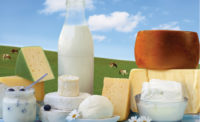Skim through any list of food and beverage megatrends and you’ll likely run across a mention of 1) probiotics, 2) digestive health, 3) the human microbiome or 4) some combination thereof. That’s because the more consumers learn about how the goings-on in their guts reverberate throughout their bodies, the more they want to know about the “good gut bugs” at the center of it all.
The upshot: The global probiotic ingredients market clocked in at $36.6 billion in 2015 and is slated nearly to double that — climbing above $64 billion — by 2023, according to a May 2016 analysis by Global Market Insights Inc., Selbyville, Del.
Such projections should be music to the ears of dairy innovators. After all, no other food and beverage category is more associated in consumers’ minds with probiotics than dairy. But taking full advantage of the probiotic megatrend is by no means a done deal, even with live and active dairy cultures on your side. For if there’s one key insight that’s emerged from the ongoing revolution in probiotic research, it’s that although probiotics may be live and active cultures, live and active cultures aren’t necessarily probiotics.
So dairy developers eager to formulate products that satisfy rising probiotic demand will have to do more than let nature — and traditional fermentation — take its course. Delivering on probiotics’ promise requires sorting out the available strains, the applications in which they’re appropriate and the health benefits they can help consumers attain.
Go for the gut, and beyond
Probiotics’ popularity is a testament not only to the primary role of health and wellness in guiding consumers’ choices, but also to the empowerment those consumers now feel in taking their health and wellness into their own hands.
“People are starting to see research — both through advertising and mainstream media — that makes them more aware of the probiotic offerings on the market,” said Sarah Hansen, scientist, probiotics R&D for DuPont Nutrition & Health, Madison, Wis. “And better scientific and clinical studies are showing real results versus previous information that may have been more anecdotal. People now understand the science more, and we know that our microbiota play a much bigger role in our bodies than we ever thought.”
How big? Suffice it to say that it’s been a while since we thought those “good gut bugs” were good solely for the gut.
“There are many solid published clinical studies, systematic reviews and meta-analyses on probiotic benefits,” said Johanna Maukonen, global health and nutrition science leader for DuPont Nutrition & Health.
Evidence for the bacteria’s ability to reduce the risk of antibiotic-associated diarrhea, necrotizing enterocolitis, respiratory tract infections and Clostridium difficile-associated diarrhea is plentiful, Maukonen said. And when it comes to probiotics’ ability to address conditions such as irritable bowel syndrome, inflammatory bowel disease, bacterial vaginosis and abnormal serum cholesterol levels — among others — she called the available supporting data “fair.”
The few studies conducted to date on probiotics’ potential to prevent dental caries, alleviate depression and assist in weight management, meanwhile, have yielded inconsistent or inconclusive results. Nevertheless, the excitement and speculation continue to run high.
The dairy link
Not surprisingly, probiotics’ potential benefits have sent health-aware consumers to stores in search of products that they expect to contain live and active probiotic cultures. And often, those products have been in the dairy aisle.
“Dairy is one of the original sources of probiotics and among the first category of products claiming to have ‘live and active cultures,’” Hansen pointed out. “People know that probiotics are bacteria and know that yogurt contains bacteria, so there is a natural connection there.”
According to Michael Bush, executive director at Kerry for the GanedenBC30 and Wellmune brands, Cleveland, the link between dairy and probiotics “is very much a marriage of convenience.” Why?
“Most strains of probiotic bacteria need to be refrigerated to survive,” he explained, “and, therefore, the refrigerated dairy case is an obvious home for them.”
The probiotic-dairy relationship is both historical and logical.
But “it’s also a source of confusion, leading consumers to think all live microbes are probiotics,” said Mirjana Curic-Bawden Ph.D., principal scientist, application manager, fermented milk and probiotics for Chr. Hansen, Milwaukee.
And the truth is, most of them are not.
Fortification or bust
The reason lies in the definition that the World Health Organization spelled out for probiotics in 2001, classifying them as live microorganisms that, when administered in adequate amounts, confer a health benefit on the host.
“The key words here,” Curic-Bawden noted, “are ‘live,’ ‘adequate amounts’ and ‘health benefit.’ And while yogurt, kefir and buttermilk cultures all acidify, ferment milk and produce flavor and texture, they do not have a health effect.”
Even if they did, there’s no guarantee that they’d be present in a fermented dairy product in adequate amounts to produce the expected benefit, or that they’d even still be alive and capable of doing so. After all, the pasteurization process that many fermented dairy products undergo can lay waste to bacteria.
“And depending on storage conditions, cultures used and other manufacturing processes,” Bush added, “fermented dairy products may contain only a small fraction of the live and active cultures included at the time of manufacture.”
So even if a dairy product already hosts rank-and-file cultures, manufacturers eager to ride the probiotic wave have little choice but to go one step further and fortify with “high-quality, science-backed probiotic strains that’ve been shown to survive in the application to confer a health benefit,” Bush concluded.
Strain significance
Bush’s comment underscores the importance of strain selection to the probiotic R&D process.
As Curic-Bawden explained, “Probiotic strains are specially selected for their intended health benefits — e.g., a probiotic strain that produces compounds that help bind to the intestinal mucus or that trigger an innate immune response.”
And it’s critical that food manufacturers understand the “nuanced but important differences” among strains, Bush said.
“A frequent misunderstanding is that they’re all the same,” he noted.
Because probiotic properties are so strain-specific — touching upon everything from their efficacy and safety to application suitability — dairy processors cannot take the positive findings in one study for a particular strain and rely on them to “substantiate the digestive health benefits” of another strain, Bush said.
But developers who use his company’s patented probiotic Bacillus coagulans GBI-30, 6086 — trade named GanedenBC30 — can feel comfortable citing the evidence for its digestive and immune benefits in making related health claims.
“And in addition to clinical work showing digestive and immune support,” Bush said, “initial research has shown that GanedenBC30 enhances the body’s ability to use protein efficiently, making it an excellent ingredient in sports nutrition and meal replacement products.”
Maukonen noted that her company has developed several Bifidobacterium animalis subspecies lactis strains that pay varying health dividends.
“B. lactis B420 helps in weight management,” she pointed out, “whereas B. lactis HN019 is excellent for gut comfort, and B. lactis BI-04 promotes a healthy immune response.” (The series of numbers included in all these names denotes the specific probiotic strain.)
But do consumers — seemingly so informed and enthusiastic about probiotics — fully appreciate the extent to which strain determines efficacy?
“Some probably understand the difference and actively look for products with a documented probiotic strain,” Curic-Bawden surmised. “However, there are also consumers still trying to interpret a barrage of conflicting information so that they can make the best choices for themselves and their families.”
Genus generalities
Whether or not consumers appreciate a strain’s significance isn’t nearly as important as the attention dairy developers pay to a particular strain’s attributes. And that’s not just because of strain-specific health implications; whether or not a probiotic can survive long enough in an application to ultimately benefit the consumer also depends, to some extent, on strain.
Probiotics suppliers also face challenges in terms of growing certain strains and keeping them viable.
“We can find the best strains, but if we can’t grow them, we can’t get them to consumers, Hansen said. “And then there are certain strains that we can grow economically, but keeping them alive is difficult.”
To understand why some probiotics tolerate certain applications better than others, it helps to know a bit about the three genera of bacteria that comprise most of the strains we know to be probiotic — namely, Lactobacillus, Bifidobacteria and Bacillus.
The former two genera are made up primarily of vegetative bacteria, meaning their cells are vulnerable to high heat, desiccation and the extreme pH common to the stomach and small intestine. These Lactobacillus and Bifidobacteria appear frequently in dairy products, and not by coincidence: Their fragility makes refrigerator temperatures necessary to keeping them viable. The flipside is that products designed to be shelf-stable, frozen, heated or exposed to abusive manufacturing processes aren’t the best environments for them.
Probiotics of the Bacillus genus, on the other hand, are “hardy, spore-forming bacteria that act as vegetative bacteria when conditions are optimal for growth, but that can form dormant spores when conditions are detrimental,” Bush explained.
Bacillus spores protect the bacterial cells, resisting extremes of pH, heat, cold and pressure better than vegetative cells do, he said. That makes them a better fit for fortification in many foods and beverages, including those that are heated, frozen, acidic, shelf-stable or subject to tough manufacturing procedures.
So manufacturers hoping to formulate a product destined for the shelf, oven or freezer should consider Bacillus strains, Bush said, pointing to B. coagulans and B. subtilis as “the prime genus and species.”
But as is the case with bacteria in the Lactobacillus and Bifidobacteria genera, some Bacillus strains qualify as probiotics, but many others don’t.
“Without clinical evidence, it’s not possible to say which are truly probiotic,” Bush pointed out. “So it’s crucial to choose a Bacillus strain backed by research for safety and specific health benefits.
They will survive
Beyond selecting a strain that ticks off all the boxes for survivability and probiotic prowess, dairy developers could work with their probiotic suppliers to find options specially designed to meet the needs of robust in-application behavior.
“Suppliers are always innovating with growth conditions, drying and encapsulation technologies and stabilizing ingredients to get better growth and stability,” Hansen pointed out. “The one thing we can’t do is genetically alter the probiotic strains. One single genetic difference makes it a new probiotic strain, so we always have to be careful. This is why we have genetic testing and research in place to make sure our strains are what we say they are.”
Savvy suppliers also offer a foundation of knowledge as to how dairy manufacturing and storage conditions affect their proprietary strains.
“And if we can, we help our customers optimize for probiotic stability,” Hansen said. “We’re also looking for new clean-label stabilizers to increase stability. And we’ve helped manufacturers customize their products through culture systems, pH, sugar inclusion or fruit-prep choices that increase the likelihood of survival. Finally, we help customers monitor stability throughout shelf life and adjust inoculation as necessary.”
It’s a suite of benefits almost as impressive as those of the probiotics themselves — all of which bodes well for the category’s future.
“With a multitude of strains available,” Bush said, “manufacturers are sorting through options to choose science-backed probiotics that can be formulated into better-for-you versions of everyday foods and beverages. The ingredients that’ll win out will be well-studied probiotics that convey a benefit-driven story that consumers can understand and trust.”






